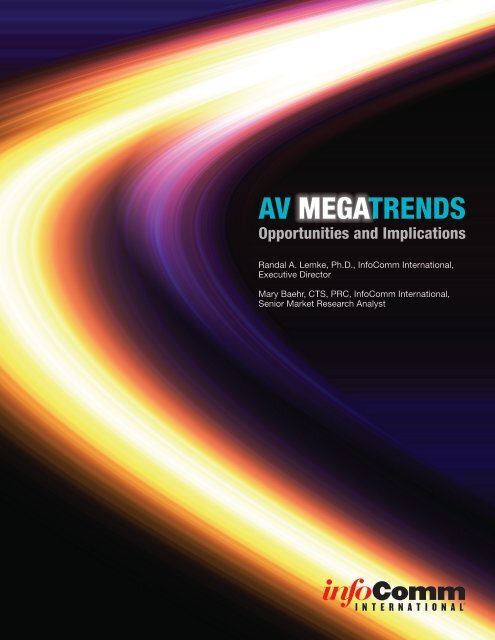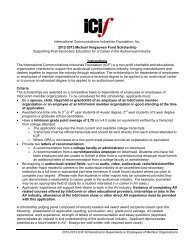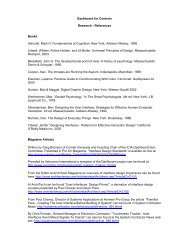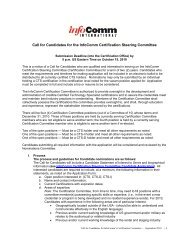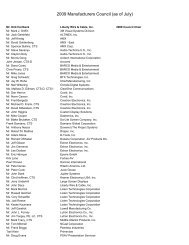AV trends MegA - InfoComm
AV trends MegA - InfoComm
AV trends MegA - InfoComm
Create successful ePaper yourself
Turn your PDF publications into a flip-book with our unique Google optimized e-Paper software.
<strong>AV</strong> Mega<strong>trends</strong> Opportunities and Implications<br />
<strong>AV</strong><br />
Mega<strong>trends</strong><br />
Opportunities and Implications<br />
Randal A. Lemke, Ph.D., <strong>InfoComm</strong> International,<br />
Executive Director<br />
Mary Baehr, CTS, PRC, <strong>InfoComm</strong> International,<br />
Senior Market Research Analyst
<strong>AV</strong> Mega<strong>trends</strong><br />
Opportunities and Implications<br />
Randal A. Lemke, Ph.D., <strong>InfoComm</strong> International,<br />
Executive Director<br />
Mary Baehr, CTS, PRC, <strong>InfoComm</strong> International,<br />
Senior Market Research Analyst<br />
In 1982 John Naisbitt wrote Mega<strong>trends</strong> (1982) and<br />
foretold the future in which we live in today. In this<br />
international best seller, he discussed 10 <strong>trends</strong><br />
that moved the world from the Industrial Age to the<br />
Information Age. At the same time Alvin Toffler wrote the<br />
Third Wave (1980), which provided additional dimension<br />
to a future dependent on the ability to collect, organize,<br />
understand and make decisions with information.<br />
Twenty-five years ago the <strong>AV</strong> industry was part of the<br />
emerging worldwide trend promising the capability<br />
to organize and present information to facilitate<br />
understanding and decision making. Displaying data in<br />
graphical formats in front of a group of decision makers<br />
was possible when our industry provided our first data<br />
projectors that went well beyond what could be done<br />
with viewgraphs on an overhead projector. Engineers<br />
could suddenly view CAD drawings in high resolution<br />
graphics. College students saw new relationships in<br />
data when it was displayed on LCD panels illuminated<br />
by overhead projectors. From command and control<br />
centers, to boardrooms, to classrooms, the <strong>AV</strong> industry<br />
enhanced people’s ability to understand data and make<br />
decisions. Today the client’s content is delivered via the<br />
network and we see it, hear it and manipulate it in a<br />
world of unified communications.<br />
The <strong>AV</strong> Megatrend continues. We are still at the heart of<br />
a cultural and business preference for visual and aural<br />
information. At the recent meeting of the <strong>InfoComm</strong> 100<br />
(2009), industry leaders identified the <strong>AV</strong> Megatrend<br />
and saw its expression in many forms, including the<br />
newest social media tools and 3-D displays, complete<br />
with the accompanying client demand for information<br />
that is available anywhere and anytime. While we<br />
should not always jump to the conclusion that today’s<br />
newest tool will determine our future, there is a long line<br />
of scholarly research that points to the effectiveness<br />
of visual communication. Consider research that<br />
Hewlett-Packard offered in “The Power of Visual<br />
Communication” (2004) including:<br />
“The psychologist Jerome Bruner of New York<br />
University has described studies that show that<br />
people only remember 10% of what they hear<br />
and 20% of what they read, but about 80 percent<br />
of what they see and do.”<br />
“Training materials used by the federal<br />
government cite studies indicating that the<br />
retention of information three days after a<br />
meeting or other event is six times greater when<br />
information is presented by visual and oral means<br />
than when the information is presented by the<br />
spoken word alone. The same materials also cite<br />
studies by educational researchers suggesting<br />
that 83% of human learning occurs visually.”<br />
“Researchers at the Wharton School of Business<br />
compared visual presentations and purely<br />
verbal presentations and found that presenters<br />
using visual language were considered more<br />
persuasive by their audiences, 67% of whom felt<br />
that presenters who combined visual and verbal<br />
components were more persuasive.”<br />
How does that translate into a business opportunity?<br />
<strong>InfoComm</strong>’s Market Definition and Strategies Studies in<br />
North America (2007), Europe (2006) and Asia (2008)<br />
all point to a worldwide market of $75 billion U.S. and<br />
annual growth rates of 10-12 percent. The strong<br />
cultural trend toward visual communication along with a<br />
real and growing market is the environment that the <strong>AV</strong><br />
industry works within — it is a great opportunity.<br />
With this bright future comes client demands for access<br />
to all content, all the time and by anybody on the<br />
network. For businesses and organizations alike, <strong>AV</strong><br />
technology transitions from a “nice to have” capability,<br />
to a “must have,” and with it comes the responsibility<br />
to deliver 99 percent uptime and interfaces that are<br />
intuitive, elegant and generalized. As it progresses,<br />
this favorable trend will be both comfortable and<br />
challenging. But the discomfort must be dealt with,<br />
because if the <strong>AV</strong> industry does not capitalize on the<br />
opportunity someone else will.<br />
© Copyright 2009, <strong>InfoComm</strong> International 2
<strong>AV</strong> Mega<strong>trends</strong> Opportunities and Implications<br />
Other Industries and Clients Will Go After<br />
the Larger Market<br />
Opportunity draws new players and new relationships.<br />
Other industries including telecommunications,<br />
information technology, security and others have the<br />
same electronic blood as <strong>AV</strong>. At one time <strong>AV</strong> was all<br />
analog, but between the input and output transducers<br />
there are now digital devices that operate on pathways<br />
that <strong>AV</strong> shares with other industries. Processing and<br />
routing digital information is done by many industries<br />
and those that can do it will be attracted to the <strong>AV</strong><br />
industry. More hardware and software manufacturers<br />
and their distribution channel will enter the <strong>AV</strong> market<br />
because they have the same digital blood type. There<br />
is no stopping the entry of new players, and in fact<br />
the best path is to embrace the new opportunities<br />
presented by their entry.<br />
The new and expanded <strong>AV</strong> Megatrend operates in<br />
a world of Internet pricing, client-provided product,<br />
and reverse auctions that challenge all enterprises<br />
to examine how they do business. It is easy to<br />
conclude that providers (manufacturers, system<br />
integrators, design consultants, live events companies,<br />
programmers, sales representatives and presentation<br />
professionals) need to have a relationship with their<br />
client in order to keep from being just a commodity<br />
provider. It can be difficult, but the creation and care<br />
of a long-term relationship is vital, and it begins with<br />
consultive selling. The relationship with the client should<br />
be continuous, because the knowledge gained about a<br />
client’s needs should continually renew the relationship<br />
so that the provider is always top-of-mind, not just<br />
on a bidders’ list. The sale of engineering and design<br />
services, programming, and value added service after<br />
the installation is where the provider can stand out from<br />
competitors – one of which is the client.<br />
The “new client” as the market expands will not only<br />
shop for the low-priced boxes, but will also become<br />
an “in-house” competitor. They will be guided by IT<br />
departments which a few years ago gained the IT<br />
knowledge to do the simple, and sometimes the most<br />
complex, computer systems itself. As the budget<br />
for <strong>AV</strong> increases, this will be a challenge to providers<br />
because in many organizations <strong>AV</strong> is now a part of<br />
the IT department and the client will likely expand its<br />
capabilities to be its own <strong>AV</strong> provider. Higher-order<br />
engineering for acoustics, videoconferencing and other<br />
“hard to do” projects will continue to be opportunities,<br />
while simple “hang and bang” jobs will become larger in<br />
number but lower in margins.<br />
When <strong>AV</strong> moves from being a “nice to have” to a “need<br />
to have” along with it comes the client demand for 99%<br />
uptime and superior performance. After all, it is the<br />
client’s ultimate responsibility to deliver high functioning<br />
reliable systems to its internal clients at a reasonable<br />
cost. Unlike an outside provider, they can’t go back to<br />
the shop and look for another client when the CEO is<br />
unhappy; their CEO is in their shop complaining. Part<br />
of that long-term relationship is making the in-house<br />
staff look good, because it make sense to keep a client<br />
instead of going out to sell services to a new one.<br />
It is About Communication, Not Hardware,<br />
and Not Even Software<br />
The <strong>AV</strong> Megatrend opportunity has moved beyond<br />
selling to the early adopters who care about hardware<br />
and software as much as the industry does. Those<br />
“<strong>AV</strong> Geek” clients are still there, but they are usually in<br />
positions where they get their budget and direction from<br />
upper management that just wants to communicate –<br />
they don’t need to know or care how it works.<br />
The <strong>AV</strong> industry comes from a heritage of hardware, and<br />
in the last 15 years it has focused on the integration of<br />
input and output transducers, signal transformation and<br />
distribution, and user control devices. Digital signaling<br />
and software systems are growing in the middle ground<br />
between input and output transducers. Analog systems<br />
that 10 years ago were built in four racks now fit into<br />
two because the digital systems need fewer boxes<br />
while being more powerful. Programming of these digital<br />
boxes is a key skill, and providers are employing both<br />
in-house and independent programmers to meet the<br />
need for programming hardware devices, as well as for<br />
control systems that tie together all the hardware and<br />
software components.<br />
The rubric is <strong>AV</strong>/IT convergence and the debate runs in<br />
the industry between how rapidly it is happening, or if it<br />
is already done. The answer in the debate means less<br />
than the premise – that the <strong>AV</strong> industry, if not already,<br />
will be a digital-based industry. Those that fail to learn<br />
that lesson will be less successful and are doing it at<br />
their own peril. Capitalizing on the <strong>AV</strong> Megatrend relies<br />
on the provider’s ability to provide networked solutions<br />
that meet the needs of the client which wants to use<br />
its communication systems anywhere, anytime. To do<br />
so, software skills must be learned, bought, rented, or<br />
hired as companies’ capabilities will be measured on<br />
the number of accredited software, as well as hardware,<br />
engineers.<br />
3
<strong>AV</strong> Mega<strong>trends</strong> Opportunities and Implications<br />
Does it end there? Does the future <strong>AV</strong> provider only<br />
need to list its capabilities as design, engineering,<br />
installation, programming, and after-the-sale valueadded<br />
service? Today that may be true, but the<br />
provider needs to remember the ultimate client. The<br />
one that sets the budget and expands usage is not<br />
the <strong>AV</strong> Geek, and is not as concerned about hardware<br />
and software capabilities (perhaps even dismissing<br />
them as back-of-the-house issues) because the real<br />
issue is communication. At the <strong>InfoComm</strong> 100, it was<br />
summarized as “Making visions a reality: Clients will<br />
expect providers to make their dreams and visions into<br />
a practical reality.”<br />
The <strong>AV</strong> industry often limits its scope when the client<br />
begins to talk about content. It certainly listens to<br />
the client describe what content and communication<br />
are needed, but with an ear to providing the systems<br />
so someone else can provide that content and<br />
communication. At its peril the <strong>AV</strong> industry will continue<br />
to shy away from content and leave that to someone<br />
else – peril because communication is what the ultimate<br />
client is concerned about.<br />
In the <strong>AV</strong> industry, those who produce live events<br />
currently marry together hardware, software and<br />
content. For them it is the “show” that drives the<br />
system and they know clearly that the show is what<br />
will earn them new business and keep clients, not the<br />
hardware and software used. Providers of installed<br />
systems need to look for ways to be part of the “client’s<br />
show” throughout the year. Providers with producers<br />
of presentations, conferencing, distance learning, and<br />
other content applications of the installed systems will<br />
have another sale to make and another connection to<br />
its client. Those providers may make these services<br />
available from in-house talent or via agreements with<br />
outside companies or individuals; or take a very active<br />
role in providing training to the client’s internal staff so<br />
that they can get their expected return on investment.<br />
The Word is Sustainability and Economics<br />
Will Drive It with the Government Steering<br />
Recent studies on polar ice caps and popular movies,<br />
such as An Inconvenient Truth, have made everyone<br />
take a closer look at the planet and how human beings<br />
are using and abusing it. While sustainable business<br />
practices may be a newer concept, the decision<br />
makers of tomorrow have always had Earth Day, and<br />
see green living as a necessity, not just a nice-tohave.<br />
Their social values will drive their preferences<br />
toward products and companies that share similar<br />
values regarding green initiatives and sustainability. As<br />
the price of energy increases, the social value will be<br />
reinforced with the economic reality that sustainability<br />
produces a better bottom line.<br />
The government has several initiatives in place to<br />
help stimulate the demand for green products. Home<br />
owners and business owners can reduce their taxable<br />
income based on qualifying energy efficient product<br />
purchases and there is a significant amount of money<br />
in the U.S. Government’s recent stimulus package<br />
earmarked for sustainable projects and initiatives.<br />
Of the $787 billion in the American Recovery and<br />
Reinvestment Act (ARRA), $78.6 billion is specifically<br />
for sustainable initiatives (de Morsella, 2009). The U.S.<br />
Department of Energy will be getting $30.7 billion as<br />
part of the stimulus package and it is this portion of the<br />
stimulus package that the <strong>AV</strong> industry could attempt to<br />
capitalize on.<br />
Beyond government stimulus funds, green and<br />
sustainable practices are here to stay. The U.S.<br />
Environmental Protection Agency has put in place<br />
programs such as ENERGY STAR and Environmentally<br />
Preferable Purchasing to promote energy efficient<br />
homes and businesses and to stimulate demand<br />
for environmentally friendly products and services<br />
(Urban Sustainability & the Build Environment, 2007).<br />
These programs are providing a competitive edge to<br />
companies that are adopting their practices.<br />
LEED ® (Leadership in Energy and Environmental<br />
Design) projects are seen as desirable by building<br />
owners because of the lessening of environmental<br />
effects, but when the savings are calculated a LEED<br />
project can also save money. The marriage of financial<br />
and environmental benefits is what makes green<br />
sustainable.<br />
The <strong>AV</strong> industry has valued green practices for years<br />
without actually touting them. Control systems can be<br />
programmed to turn off all devices when a room is not<br />
in use, to draw shades on windows to reduce heat in<br />
the summer months, control HVAC and many other<br />
functions. Conferencing systems reduce the need for<br />
travel, increasing employee productivity. Providers<br />
in the <strong>AV</strong> industry need to take a better look at their<br />
products and services, and quantify how they save their<br />
clients’ time, money and energy. They must evaluate<br />
current products and services, decrease deleterious<br />
environmental impacts or make them environmentfriendly,<br />
and convey their shared commitment to<br />
sustainability with their clients.<br />
4
<strong>AV</strong> Mega<strong>trends</strong> Opportunities and Implications<br />
The <strong>AV</strong> Megatrend is Global<br />
The opportunities for the <strong>AV</strong> industry are everywhere.<br />
<strong>InfoComm</strong>’s trade shows in Amsterdam, Moscow,<br />
Beijing, Hong Kong, and previously in Singapore,<br />
Tokyo and Shanghai all demonstrate that the same<br />
technology is used everywhere. Changes in power<br />
supplies and other small technical differences are<br />
handily accommodated by manufacturers. The<br />
distribution channel has similarities everywhere, with<br />
the notable differences in the role of distributors<br />
worldwide and the joining of residential and<br />
commercial outside of North America.<br />
<strong>AV</strong> and its communication capability is one of<br />
the tools of globalization in the same way that<br />
telecommunications, IT and other technologies span<br />
the world and allows organizations to operate across<br />
country boundaries. In North America and Western<br />
Europe, technical development, business practices and<br />
culture are similar. Moscow, Beijing and other quicklydeveloping<br />
economies are making similar technical<br />
developments even though the business practice and<br />
culture are different. A common theme is that high-tech<br />
<strong>AV</strong> applications are first applied by global organizations,<br />
mostly Western companies, and then domestic<br />
organizations adopt similar applications.<br />
The <strong>AV</strong> Megatrend is everywhere. Even in the most<br />
print- and verbal-oriented cultures, the use of mediated<br />
communication is growing as the popular culture makes<br />
the same change. In addition to catering to the current<br />
global players as they enter new markets, development<br />
of the local market is a big opportunity. Global<br />
opportunities will abound and global providers will also<br />
flourish. The new markets have adopted technology<br />
from the established, but they are also creating their<br />
own. The <strong>AV</strong> industry will have more manufacturers,<br />
more integrators, more consultants, more distributors,<br />
and more of all kinds of <strong>AV</strong> companies from all over<br />
the world. Talent and competitive drive are equally<br />
dispersed in the world, so in a developing market<br />
when talent is educated and markets are enabled,<br />
the global output in our industry will be more equally<br />
dispersed. Currently, Western <strong>AV</strong> integrators and<br />
design consultants are developing businesses around<br />
the world, but new local providers are also serving<br />
their own markets. These local providers will not only<br />
serve their domestic market... they will compete with<br />
providers from around the world anywhere in the world<br />
– it will be a two-way street.<br />
Other boundaries will also change with the growth of<br />
the global market. No longer will it be the industry of<br />
the “<strong>AV</strong> Geek” because it will attract more women,<br />
more races and more ethnic groups. The change in<br />
demographics will bring with it new capabilities to sell<br />
to and satisfy the broader market of buyers. Because of<br />
the <strong>AV</strong> Megatrend, the industry will attract the non-<strong>AV</strong><br />
Geek with an MBA who buys or starts an <strong>AV</strong> company<br />
simply because it will be a good business investment.<br />
The new players and a growing business sophistication<br />
will enable even more growth.<br />
Beware of and Embrace Disruptive<br />
Technology and Competition<br />
Our industry relies on technology that is always<br />
improving and changing, and therefore the definition<br />
of the <strong>AV</strong> industry is going to be a living definition.<br />
But anyone who thinks that <strong>trends</strong> continue without<br />
disruption needs to rethink that assumption. In the IT<br />
world, mainframe computer makers never believed that<br />
mini-computers could ever challenge their dominance.<br />
And then mini-computer makers never thought that<br />
the personal computer could put them out of business.<br />
And today, with millions of users around the globe, it is<br />
the iPod and mobile phones that possess ever-growing<br />
processing power, applications and utility. Anybody<br />
established in a leadership position may be tempted<br />
at their peril to see new products or applications as a<br />
competitive nuisance, but not a real threat.<br />
“The 10 Most Disruptive Technology Combinations,”<br />
listed in PC World discusses, among other examples,<br />
how MP3s made audio files small, portable and<br />
convenient (Tynan, 2007). With compact audio files,<br />
companies like Napster made it easy to share music,<br />
and the recording industry was in an uproar. CDs are<br />
now on the way out as the client seems to prefer buying<br />
only the songs they like even though the quality of an<br />
MP3 does not match a CD. Little-known artists that<br />
couldn’t afford to distribute the quantity of CDs needed<br />
to sell in major stores across the country now reach<br />
individuals anywhere there is an Internet connection. At<br />
the same time, Apple created an easy-to-use recording<br />
studio in the Macintosh and again the little-known artist<br />
was given a more affordable way to produce music.<br />
5
<strong>AV</strong> Mega<strong>trends</strong> Opportunities and Implications<br />
Recording studios and record labels both suffered<br />
from these two technologies, while the consumer says<br />
that it benefited from these disruptive technologies.<br />
How will providers react to the next big “must-have?”<br />
Is there a killer app headed toward the <strong>AV</strong> industry<br />
that disrupts how business is done? New technologies<br />
and new practices happen and <strong>AV</strong> industry members<br />
need to always keep an eye open and a flexible<br />
business plan ready.<br />
How you prepare for change can help dictate how<br />
successfully your organization moves through the next<br />
disruptive change. Is your company diversified in its<br />
revenue streams? Do you keep up with the technical<br />
and business pulse inside and outside of the industry?<br />
Do you have a good relationship with clients, listening<br />
to their needs and feedback to see where they are<br />
headed? How are your products being used in ways<br />
that the engineer who designed it may not have<br />
thought of?<br />
The <strong>AV</strong> Megatrend will accentuate innovation and<br />
competition, but this kind of change and challenge<br />
make it an exciting industry. Business and technical<br />
models must be fluid in order to adapt to the changes<br />
within and outside of the industry to continue to serve<br />
current clients and the new clients that are yet to<br />
appear.<br />
Be Part of the <strong>AV</strong> Megatrend<br />
It is often said that the only constant variable is change.<br />
In the <strong>AV</strong> industry, we often revel in the dynamic nature<br />
of our products, clients and businesses. But in the end,<br />
change is not easy and it is almost always threatening.<br />
The <strong>AV</strong> Megatrend is an opportunity that is welcomed<br />
for its potential and the financial success it promises.<br />
But providers have to compete for that bigger market<br />
and to do so will challenge most of what is done today<br />
as standard business practice. The client is going<br />
to be different, with more of them and with bigger<br />
projects, but they will have different needs and will<br />
want to work in new ways. One difference will be their<br />
and societal demands for sustainability and <strong>AV</strong> will<br />
not be left out of the green movement. So far <strong>AV</strong> has<br />
not been top of mind for LEED or ENERGY STAR, but<br />
like all other industries it will be challenged to provide<br />
communication solutions that lead to sustainability.<br />
The <strong>AV</strong> Megatrend will take companies around the<br />
world, and a global market is a two-way market as<br />
talent is everywhere and it will search out opportunity<br />
everywhere. Every company will be looking for the<br />
next best product or service for its new clients, and<br />
sometimes that technology will overturn the current<br />
world of <strong>AV</strong> communication. Be ready to succeed in<br />
the <strong>AV</strong> Megatrend.<br />
Bibliography<br />
de Morsella, T. (2009). The Stimulus Bill Includes Numerous Green Initiatives – Find out Exactly What They Are. Retrieved May 21,<br />
2009, from The Green Economy Post<br />
Website: http://greeneconomypost.com/stimulus-bill-green-initiatives-533.htm.<br />
Hewlett-Packard Development Company, LP. (2004). The Power of Visual Communications. Retrieved May 21, 2009 from the<br />
Hewlett-Packard Website: http://www.hp.com/large/ipg/assets/bus-solutions/power-of-visual-communication.pdf.<br />
<strong>InfoComm</strong> International. (2006). 2007 <strong>AV</strong> Market Definition and Strategy Study: Europe.<br />
<strong>InfoComm</strong> International. (2007). 2007 <strong>AV</strong> Market Definition and Strategy Study: North America.<br />
<strong>InfoComm</strong> International. (2008). 2007 <strong>AV</strong> Market Definition and Strategy Study: Asia-Pacific.<br />
<strong>InfoComm</strong> International. (2009). <strong>InfoComm</strong> 100... A View on the Near Future of the <strong>AV</strong> Industry.<br />
Naisbitt, J. (1982). Mega<strong>trends</strong>. New York: Warner Books.<br />
Toffler, A. (1980). The Third Wave. New York: Bantam Books.<br />
Tynan, D. (2008). The 10 Most Disruptive Technology Combinations. Retrieved May 21, 2009, from the PC World<br />
Website: http://www.pcworld.com/article/143474/the_10_most_disruptive_technology_combinations.html.<br />
Urban Sustainability & the Built Environment (2007). Retrieved May 21, 2009, from the U.S. Environmental Protection Agency<br />
Website: http://www.epa.gov/sustainability/builtenvironment.htm.<br />
6


